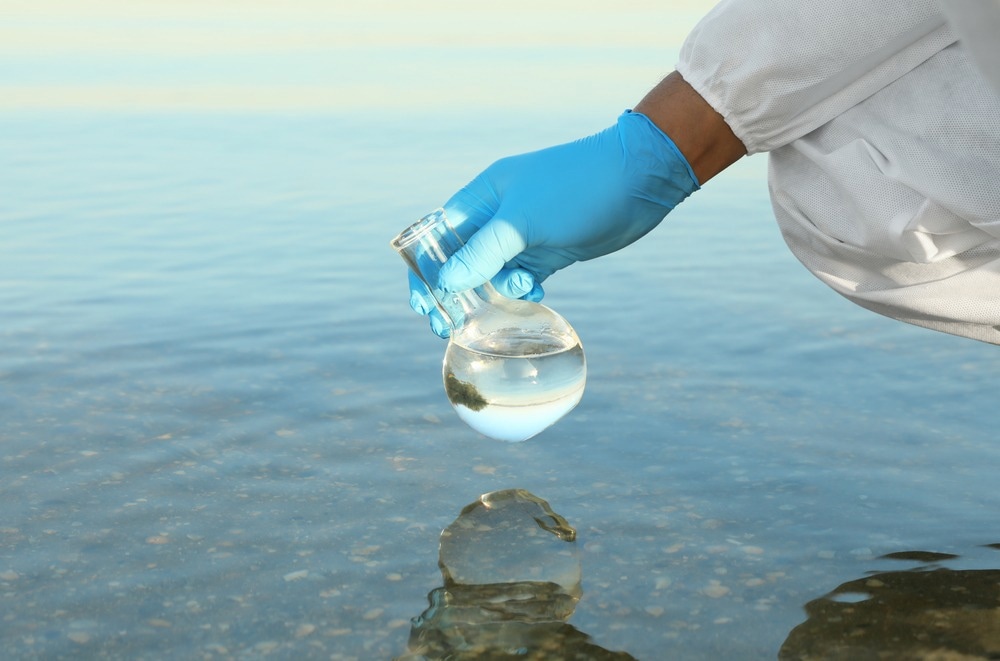Nanoplastics have become an increasingly concerning issue in the water we drink and use daily. These particles are difficult to remove using standard water treatment methods, and their persistence in the environment and potential negative effects on human health make it imperative to develop effective removal techniques.

Image Credit: New Africa/Shutterstock.com
In this article, AZoNano will delve into the implications of nanoplastics in water, the current challenges in their removal, and the promising techniques being developed to address this growing problem.
Problems Caused by Nanoplastics in Water
The presence of nanoplastics in water has become an increasingly concerning issue as they are not only present in oceans and rivers but also in tap water, bottled water, and even in some foods. These tiny plastic particles, measuring less than 100 nanometers, are not easily filtered out by traditional water treatment methods.
The persistence of these particles in the environment and the potential for negative effects on human health make it crucial to explore and implement effective removal techniques.
The implications of nanoplastics in water are numerous. They can be ingested by aquatic organisms, potentially causing harm to their health. They can also make their way up the food chain, potentially affecting human health. Additionally, nanoplastics can interfere with water treatment processes, making it more difficult to provide clean and safe water for human consumption.
Techniques for Removing Nanoplastics From Water
Several methods have been researched to effectively remove nanoplastics from water. Some of these techniques are discussed below:
Removing Nanoplastics from Water Using Adsorbents
The first method we will be discussing is the use of adsorbents. Adsorbents are materials that can bind to and remove pollutants from a liquid. Researchers have found that certain clay minerals, such as bentonite and kaolin, have a high affinity for binding to nanoplastics. Additionally, some types of activated carbon have also been found to effectively adsorb nanoplastics.
Due to their large specific surface area and numerous pores, metal-organic framework carbon materials have been proposed as an adsorbent for various applications. These characteristics make them highly effective at adsorbing pollutants and make them a promising material for water treatment.
For nanoplastic removal specifically, one study discusses using a material called Cu-Ni carbon material (CuNi@C) to remove polystyrene (PS) nanoplastics from water. The researchers found that CuNi@C was able to effectively adsorb PS nanoplastics and the removal efficiency increased as the dosage of CuNi@C increased.
The study also found that physical adsorption and monolayer coverage were the predominant mechanisms of the PS nanoplastics adsorption on CuNi@C, and that the adsorption process was spontaneous and endothermic.
Additionally, it found that CuNi@C can be recycled multiple times and still effectively remove PS nanoplastics from water, suggesting CuNi@C to be a promising material for removing PS nanoplastics from the aqueous environment.

Image Credit: Dotted Yeti/Shutterstock.com
Removing Nanoplastics from Water Using Magnetic Particles
The second approach is through the application of magnetic particles, which can be used to attract and remove nanoplastics from water. These magnetic particles can be functionalized with specific ligands that selectively target certain types of plastics. The magnetic particles can then be easily separated from the water using a magnetic field.
A recent study published in Nature Communications presents a new method of capturing and detecting nanoplastics in wastewater using multifunctional MXene-derived oxide microrobots. These microrobots were created using a thermal annealing process and have the ability to move in 3D space using negative photogravitaxis. They were able to attract and trap nanoplastics on their surface due to their unique combination of self-propulsion and programmable Zeta potential and can then be collected magnetically. This proof-of-concept study suggests that this method could be used for on-site screening and remediation of nanoplastics in water.
Removing Nanoplastics from Water Using Electrochemical Techniques
The third approach based on electrochemical techniques has been extensively discussed in a recent review published in Water Research. The article discusses recent progress in electrochemical techniques for identifying and removing micro/nanoplastics (MPs/NPs) in urban waters. These techniques have gained popularity due to their ease of implementation, high efficiency, and eco-compatibility.
The article reviews the electrochemical sensing of MPs/NPs and their released pollutants and examines the principles and featured devices/electrodes used in the process. It also discusses recent applications of electrochemical methods in MPs/NPs removal, such as electrocoagulation, electroadsorption, electrokinetic separation, and electrochemical degradation.
It also analyzes the influence of critical parameters, such as plastics' properties, current density, and electrolytes, on the electrochemical identification and removal of MPs/NPs.
Biodegradable Polymers and Physical Separation Methods for Removing Nanoplastics in Water
Another removal technique being researched is the use of biodegradable polymers. These polymers can be designed to attract and bind nanoplastics, effectively removing them from water. Once the nanoplastic is bound to the polymer, it can be easily separated and removed from the water.
Finally, physical separation methods, such as microfiltration and ultrafiltration, are also being investigated as potential methods for removing nanoplastics from water. These methods use a membrane to physically separate the nanoplastics from the water.
Conclusion
It is important to note that more research is needed to fully understand the potential effects of nanoplastics on human health and the environment and to improve the effectiveness of these removal methods.
It is also important to mention that prevention is still the best way to tackle this problem by reducing the use and disposal of single-use plastics and encouraging proper waste management.
While nanoplastics in water present a significant environmental problem, several removal techniques have shown promise in laboratory settings. Further research is needed to determine their effectiveness on a larger scale and to assess the long-term effects of these techniques on the environment.
The growing trend of developing new and innovative solutions to remove nanoplastics from water brings hope. With continued research and development, it is hoped that effective and sustainable solutions to the problem of nanoplastics in water will be found.
References and Further Reading
Chen, Z., Wei, W., Liu, X., Ni, B.-J. (2022). Emerging electrochemical techniques for identifying and removing micro/nanoplastics in urban waters. Water Research 221, 118846. https://doi.org/10.1016/j.watres.2022.118846
Gigault, J., El Hadri, H., Nguyen, B., Grassl, B., Rowenczyk, L., Tufenkji, N., Feng, S., Wiesner, M. (2021). Nanoplastics are neither microplastics nor engineered nanoparticles. Nature Nanotechnology 16, 501–507. https://doi.org/10.1038/s41565-021-00886-4
Hofman-Caris, C.H.M., Bäuerlein, P.S., Siegers, W.G., Mintenig, S.M., Messina, R., Dekker, S.C., Bertelkamp, C., Cornelissen, E.R., Wezel, A.P. (2022). Removal of nanoparticles (both inorganic nanoparticles and nanoplastics) in drinking water treatment – coagulation/flocculation/sedimentation, and sand/granular activated carbon filtration. Environmental Science: Water Research and Technology. 8, 1675–1686. https://doi.org/10.1039/D2EW00226D
Keerthana Devi, M., Karmegam, N., Manikandan, S., Subbaiya, R., Song, H., Kwon, E.E., Sarkar, B., Bolan, N., Kim, W., Rinklebe, J., Govarthanan, M. (2022). Removal of nanoplastics in water treatment processes: A review. Science of The Total Environment 845, 157168. https://doi.org/10.1016/j.scitotenv.2022.157168
Liu, Q., Chen, Y., Chen, Z., Yang, F., Xie, Y., Yao, W., 2022. Current status of microplastics and nanoplastics removal methods: Summary, comparison and prospect. Science of The Total Environment 851, 157991. https://doi.org/10.1016/j.scitotenv.2022.157991
Sakharkar, A. (2022). Slow sand filter can remove 99.9% of nanoplastics from drinking water [Online]. Inceptive Mind. URL https://www.inceptivemind.com/slow-sand-filter-remove-nanoplastics-drinking-water/24937/
Urso, M., Ussia, M., Novotný, F., Pumera, M. (2022). Trapping and detecting nanoplastics by MXene-derived oxide microrobots. Nature Commununications 13, 3573. https://doi.org/10.1038/s41467-022-31161-2
Zhou, G., Huang, X., Xu, H., Wang, Q., Wang, M., Wang, Y., Li, Q., Zhang, Y., Ye, Q., Zhang, J. (2022). Removal of polystyrene nanoplastics from water by CuNi carbon material: The role of adsorption. Science of The Total Environment 820, 153190. https://doi.org/10.1016/j.scitotenv.2022.153190
Disclaimer: The views expressed here are those of the author expressed in their private capacity and do not necessarily represent the views of AZoM.com Limited T/A AZoNetwork the owner and operator of this website. This disclaimer forms part of the Terms and conditions of use of this website.